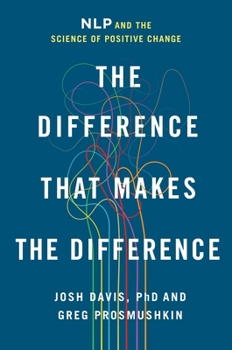The Difference That Makes the Difference: Nlp and the Science of Positive Change
Select Format
Select Condition 
Book Overview
Take control of your life and create profound change today using NLP and the science of positive change
Learn why people resist change, why they sometimes embrace change, and how to lead change quickly and in lasting ways. It all comes down to finding the difference that makes the difference for each person and context. Neurolinguistic Programming (NLP) is great for finding that difference. NLP helps us understand what makes people tick. When we understand how they think, feel, and act in key situations, we have the raw material with which to make change happen, often quickly and profoundly. In the 1970s, a linguist and his partner studied the language patterns and nonverbal cues of great psychotherapists, as well as how people are affected by the systems they're part of. The two pinpointed key aspects of what enables human beings to change. Their findings formed the basis of NLP. Since then, NLP has often been taught to therapists and life coaches aiming to master one-on-one interactions in those contexts. When the lawyer Greg Prosmushkin discovered NLP, he realized how incredibly valuable these tools could be outside a therapy context. How to communicate with confidence, model excellence, and influence your own and others' thoughts, feelings, and behaviors are useful for many people in many situations. Greg used NLP to make huge breakthroughs in his trials and to step into his own as an entrepreneur. In 2022, Greg met Josh Davis, PhD, a Columbia University PhD who studied psychology and neuroscience, and the Founder and Director of the Science-Based Leadership Institute. Josh is an NLP expert who grew up in the 1970s and 80s as the child of two pioneers in the field of NLP. He's an NLP native. He's been training others to use NLP for over a decade. Josh is also the internationally best-selling author of Two Awesome Hours, a science-based set of strategies to work less and get your most important work done. Greg and Josh set out to make NLP easily accessible for everyone. They show how the tools of NLP can be used by anyone in their daily work and personal lives, and connect these actionable tools to the science of change. The Difference that Makes the Difference is a result of their rigorous and dedicated collaboration. In this book, readers learn how to:-Communicate with confidence
-Model excellence, to learn and master new skills
-Influence their own and others' thoughts, feelings, and behaviors in positive ways
-and much more You'll get:
-Step-by-step instructions with tips
-Guided prompts to follow that help you apply these time-tested tools to your own specific needs
-Examples of how to use the tools in everyday situations
-Simple explanations of the theory and science behind the tools
-Clear explanations of why the tools are so powerful NLP has been time-tested for fifty years, but until now it has only been accessible for a select few. Books and methods of teaching NLP were complex because the subject matter was highly sophisticated and derived from the work of professional psychotherapists. Greg Prosmushkin and Josh Davis, PhD have spent a combined 35+ years studying and unlocking the value of NLP. Josh has been teaching these concepts and tools in specialized NLP trainings, as well as one-on-one and group coaching settings, to Fortune 500 audiences and beyond. They have been using these concepts and tools in their professional practices of trial law, entrepreneurship, and leadership development. They have made a careful study of how to make the complex simple to learn and apply. It's time to move past simply waiting and wishing for your life to be different―dive into the tools of NLP and the science behind change that supports those tools, to make a real impact in your life, right now.
Format:Paperback
Language:English
ISBN:1250349087
ISBN13:9781250349088
Release Date:July 2025
Publisher:St. Martin's Essentials
Length:336 Pages
Weight:0.80 lbs.
Dimensions:1.2" x 6.1" x 9.1"
Customer Reviews
0 rating





